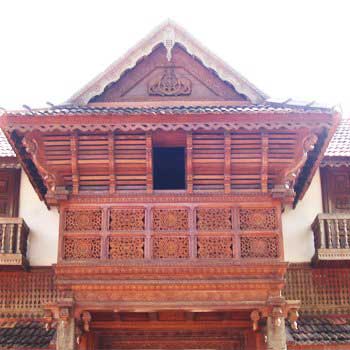Padmanabhapuram Palace - kerala
Padmanabhapuram Palace is situated around 64 Km from Trivandrum, at Thuckalay, on the way to Kanyakumari. The Padmanabhapuram Palace is a masterpiece of indigenous Kerala architecture and was once a flourishing capital of the powerful Venad Kingdom which later became famous as the erstwhile princely state of Travancore. The palace is believed to have been built by Iravi Varma Kulasekhara Perumal, the ruler of Venad, around 1601 AD and was later rebuilt by King Anizham Thirunal Marthanda Varma. Even though the region comes under the State premises of Tamil Nadu, the Padmanabhapuram Palace is owned by the Government of Kerala. The Palace is made of wood with intricate rosewood carvings, astounding sculptures and murals. This Palace is an extraordinary place with splendid sights. It has a Durbar Hall with a shiny black floor made of a mix of egg white, jaggery, lime, burnt coconut, charcoal and river sand. The temple dedicated to Goddess Saraswathi, the secret underground passages, the famous medicinal bed in the King’s bedroom, mural paintings, pictures of Lord Krishna, open-air swimming baths, fish carvings and hanging brass lanterns that have been continuously lit since the 18th century are some of the splendour of this palace. November to May is the best time to visit Padmanabhapuram Palace. Timings : All days of the week, except Monday Entrance Fee: By Air - Trivandrum International Airport is the nearest airport to Padmanabhapuram Palace which is situated at a distance of 56.2 Km. By Rail - Nagercoil Railway Station is the nearest railway station to Padmanabhapuram Palace which is situated at a distance of 16.6 Km. By Bus: Nagercoil Bus Station is the nearest bus station to Padmanabhapuram Palace which is situated at a distance of 15 Km. Who built Padmanabhapuram Palace?
The palace was originally built by Iravi Varma Kulasekhara Perumal, the ruler of Venad, in 1601 AD. It was later renovated and expanded by King Anizham Thirunal Marthanda Varma, the ruler of Travancore, who made the palace his capital. What is Padmanabhapuram Palace famous for?
Padmanabhapuram Palace is famous for its traditional Kerala architecture, intricate rosewood carvings, and impressive sculptures. Notable features include the Durbar Hall with a unique black floor, mural paintings of Lord Krishna, the medicinal bed in the king’s bedroom, and the continuously lit hanging brass lanterns from the 18th century. Where is Padmanabhapuram Palace located?
Padmanabhapuram Palace is located in Thuckalay, in the Kanyakumari district of Tamil Nadu, around 64 km from Thiruvananthapuram (Trivandrum), Kerala. Although situated in Tamil Nadu, the palace is owned by the Government of Kerala. What is the historical significance of Padmanabhapuram Palace?
Padmanabhapuram Palace was once the capital of the Venad Kingdom, which later became the princely state of Travancore. It was built around 1601 AD by Iravi Varma Kulasekhara Perumal and was later expanded by King Anizham Thirunal Marthanda Varma. The palace reflects the rich history of the Travancore dynasty. What are the main attractions of Padmanabhapuram Palace?
The main attractions of Padmanabhapuram Palace include: Is photography allowed inside Padmanabhapuram Palace?
Photography is generally not allowed inside the interiors of Padmanabhapuram Palace to preserve heritage and artefacts. However, you may be allowed to take pictures of the palace’s exteriors and surrounding areas. Always check with the authorities for the latest photography rules. What are the visiting hours and entry fees for Padmanabhapuram Palace?
Padmanabhapuram Palace is open to visitors from 9:00 AM to 4:30 PM, with a break for lunch from 12:30 PM to 2 PM. The Palace will be closed on Mondays and National Holidays.
The entry fee is typically ₹ 35 for Indian citizens and ₹ 300 for foreign nationals. However, it's advisable to check the latest fees and timings before your visit. 
Best Time to visit
Way to reach
FAQs:
• The Durbar Hall with a floor made of unique materials like egg white, jaggery, lime, and burnt coconut.
• Rosewood carvings and astounding sculptures.
• The medicinal bed in the king's bedroom.
• The temple dedicated to Goddess Saraswati.
• Mural paintings depicting Lord Krishna and other religious themes.
• The underground passages and open-air swimming baths.
• The hanging brass lanterns that have been continuously lit since the 18th century.